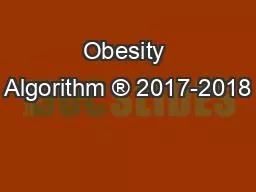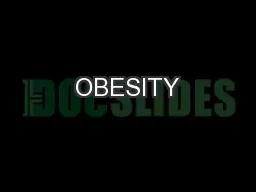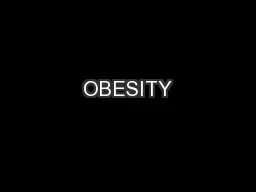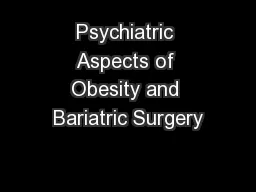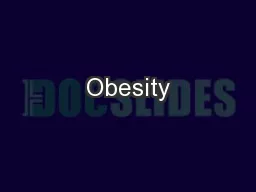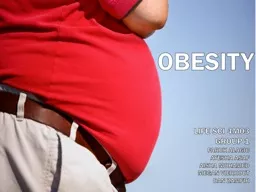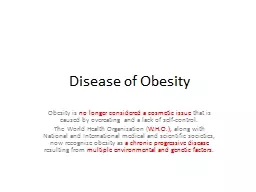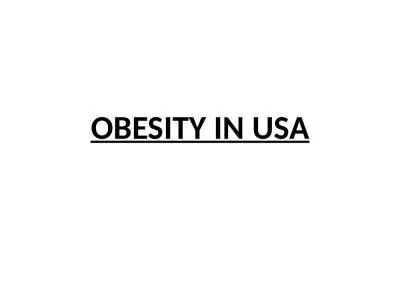PPT-Obesity Algorithm ® 2017-2018
Author : quorksha | Published Date : 2020-11-06
Obesity Algorithm 20172018 Obesity Medicine Association Disclaimer and Permissions Disclaimer The Obesity Algorithm guidelines were originally presented by the
Presentation Embed Code
Download Presentation
Download Presentation The PPT/PDF document "Obesity Algorithm ® 2017-2018" is the property of its rightful owner. Permission is granted to download and print the materials on this website for personal, non-commercial use only, and to display it on your personal computer provided you do not modify the materials and that you retain all copyright notices contained in the materials. By downloading content from our website, you accept the terms of this agreement.
Obesity Algorithm ® 2017-2018: Transcript
Obesity Algorithm 20172018 Obesity Medicine Association Disclaimer and Permissions Disclaimer The Obesity Algorithm guidelines were originally presented by the Obesity Medicine Association OMA in 2013 and have since been updated yearly to include the latest treatments and trends in the field of obesity medicine They were developed to assist health care professionals in the management and care for patients with overweight and obesity The Obesity Algorithm is not intended to be a substitute for a medical professionals independent judgment and should not be considered medical advice The content herein is based on medical literature and the clinical experiences of obesity medicine specialists In areas regarding inconclusive or insufficient scientific evidence the authors used their professional judgment . Obesity causes at least 111000 deaths per year in the United States and some researchers place that number at over 400000 Add to these figures the cases of cancer and heart diseasebrought on or worsened by obesityand the cases of type 2 diabetes cau Aaron Cheatham. Fat is just what we thought. The cause of excess subcutaneous and visceral fat deposition in an individual is the cumulative effect of an imbalance between the energy of ingested food and that expended in the course of daily activities. and BREATHING . Dr Christopher . Worsnop. Department of Respiratory and Sleep . Medicine. Austin Hospital, Melbourne, Australia. After a short visit to America, . David returns to Italy.. . . OVERVIEW. Advanced . English 10. What is Obesity?. Obesity: condition factoring because of excessive body fat. Being 20% above your following age, height, and weight range (BMI) is considered obese. In America 30-35% of the population is obese. BY MELISSA & KATLYN.. (Obesity in SA, 2013. ). What is obesity?. Obesity is a medical condition in which excess body fat has accumulated to the extent that it has an negative effect on health. .. Daniel Anzia, MD. Chairman, Psychiatry. Advocate Lutheran General Hospital. Presentation Outline. Psychiatric Disorders and Obesity. Obesity and Common Psychiatric Disorders. Primary Eating Disorders. Coke, McDonald's slam New York City bid to ban big soda cups. By . Martinne. Geller. Re…broader fight against obesity, which is a burden on the country's healthcare system.. Coke, McDonald's slam New York City bid to ban big soda cups. By Nicholas Johnson . What is obesity ?. Obesity is a defined condition where one has more body fat than average . A person with a BMI of 30 or more is obese . BMI = Body mass index . Who is effected by obesity . Cause or Effect. Claudia Fox, MD MPH. Diplomate. , American Board of Obesity Medicine. Director, Pediatric Weight Management Program. Disclosures. I have no relevant financial relationships with the manufacturers of any commercial products and/or provider of commercial services discussed in this CME activity. . India S.. . Sharp, BSN, RN. November 02, . 2013. Objectives. Provide knowledge of the pathophysiology, epidemiology, symptoms, . & non-pharmacological treatments. Obesity. Obesity is a label for ranges of weight that are greater than what is considered healthy for a given height. By: Chloe Horton Nikki Chawla. Binge eating . a usually brief period or bout of excessive eating.. Obesity. very . fat or overweight;. Facts of binge eating. binge eating is a completely separate eating disorder from bulimia nervosa and anorexia nervosa . FARUK ALAGIC. AYESHA ASAF. AISHA MOHAMED . MEGAN VIERHOUT . DAN ZAMFIR. Clinical Definition of Obesity. Obesity . is the excessive . or abnormal accumulation of fat in adipose tissue which leads to the impairment . no longer considered a cosmetic issue . that is caused by overeating and a lack of self-control. . The World Health Organization (. W.H.O.), . along with National and International medical and scientific societies, now recognize obesity as . Obesity. is a . medical condition. in which excess . body fat. has accumulated to the extent that it may have a negative effect on health, leading to reduced . life expectancy. and/or increased health problems..
Download Document
Here is the link to download the presentation.
"Obesity Algorithm ® 2017-2018"The content belongs to its owner. You may download and print it for personal use, without modification, and keep all copyright notices. By downloading, you agree to these terms.
Related Documents

